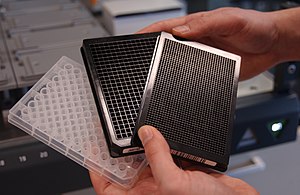Indirect immunoperoxidase assay (IPA) is a laboratory technique used to detect and titrate viruses that do not cause measurable cytopathic effects and cannot be measured by classical plaque assays. These viruses include human coronavirus 229E and OC43.[1]

Methodology
editSusceptible cells are inoculated with serial logarithmic dilutions of samples in a 96-well plate. After viral growth, viral detection by IPA yields the infectious virus titer, expressed as tissue culture infectious dose (TCID50). This represents the dilution of a virus-containing sample at which half of a series of laboratory wells contain replicating viruses. This technique is a reliable method for the titration of human coronaviruses (HCoV) in biological samples (cells, tissues, or fluids). It is also reliable in the detection of antibodies to human cytomegalovirus.[1][2]
See also
editReferences
edit- ^ a b Lambert, Francine; Jacomy, Hélène; Marceau, Gabriel; Talbot, Pierre J (2008). "Titration of Human Coronaviruses, HCoV-229E and HCoV-OC43, by an Indirect Immunoperoxidase Assay". SARS- and Other Coronaviruses. Methods in Molecular Biology. Vol. 454. pp. 93–102. doi:10.1007/978-1-59745-181-9_8. ISBN 978-1-58829-867-6. PMC 7121483. PMID 19057861.
- ^ G Gerna, C J McCloud and R W Chambers: Immunoperoxidase technique for detection of antibodies to Human cytomegalovirus. J. Clin. Microbiol. 1976, 3(3):364.
External links
edit- Lambert, Francine; Jacomy, Helene; Marceau, Gabriel; Talbot, Pierre J. (28 April 2008). "Titration of Human Coronaviruses Using an Immunoperoxidase Assay". Journal of Visualized Experiments (14): e751. doi:10.3791/751. PMC 2582848. PMID 19066576. Retrieved 15 September 2016.
- Immunohistochemistry Protocols, Buffers and Troubleshooting